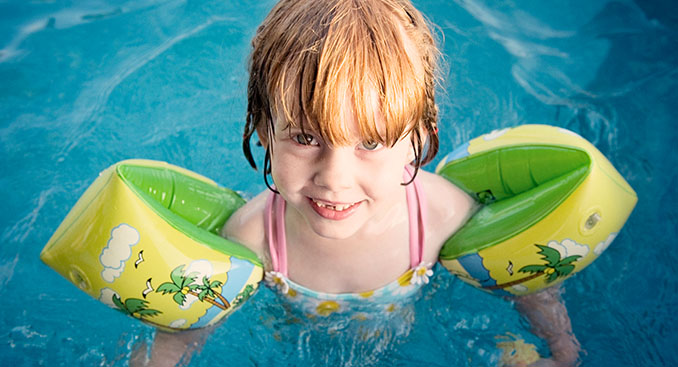Swimming Pool Safety for Young Children

As rising temperatures and a bright sun welcome the arrival of summer, parents of children of all ages will be flocking to backyard and community pools. Swimming is one of the best ways to stay cool while having fun outdoors during the heat of the summer months. It’s also a great way to ensure that children get the exercise they need for overall health. However, there are dangers associated with children and swimming pools, especially when parents don’t take the necessary precautions.
According to the Centers for Disease Control, drowning is a leading cause of unintentional injury death among children 1–14 years old and drowning kills more young children 1–4 years old than anything else except for birth defects.
“This doesn’t mean parents should be afraid to take their kids swimming,” says Marsha Walsh, aquatics coordinator for the TriHealth Fitness & Health Pavilion. “By teaching young children some basic safety lessons, taking the right precautions and especially by paying attention, parents can make swimming pools as safe as they are fun.”
To help parents ensure the safety of their children, Walsh suggests the following safety tips:
1. Know the Pool
“Knowing the pool, its potential dangers, its rules and the location of its safety equipment is very important to ensuring children’s safety when swimming,” Walsh says. “It can help you or your child be able to help yourselves or another person without having to think in the event of an emergency.” She recommends parents walk around the pool with their children before swimming and answer the following questions:
- What is the depth at each point of the pool?
- Can you dive and if so where?
- Is there a lifeguard on duty?
- What potential lifesaving tools such as floatation devices, rescue tubes and CPR masks are available and where are they?
2. Reach, Throw, Don’t Go
“Jumping into a pool to help somebody who is drowning can put a child in danger,” Walsh says, “especially if that child isn’t strong enough to keep themselves above water while a drowning person pulls at them in desperation.”
Walsh suggests that if they are able to reach a person who is drowning from solid ground, it increases the chances of saving them while cutting down on the risk of creating a second victim. She suggests laying on your belly or getting a firm stance and using something to reach out to the victim such as a shepherd’s crook or pool noodle to help pull them in.
If a victim can’t be reached from the edge, Walsh says you can throw them something buoyant to keep them afloat such as a rescue tube or life ring, which often includes a rope for pulling the victim in.
3. Never Swim Alone
“This may seem obvious, but it’s very important,” Walsh says. “Having somebody else present means there is somebody there to help in the event of an accident or to call 911 in the event an accident turns into a serious emergency. Having somebody there is always important, but it’s especially important that young children never swim without supervision.”
4. Come Prepared for the Sun and Heat
While drowning is the main concern, spending any amount of time in the hot sun, especially while participating in rigorous physical activity such as swimming, can have other negative health effects. Walsh recommends these basic precautions:
- Have plenty of water handy to stay hydrated
- Wear strong sunscreen to prevent burns and an increased risk of developing skin cancer
- Wear sunglasses to protect your eyes from prolonged exposure to harmful UV rays.